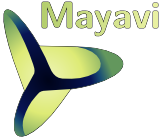Figures, legends, camera and decorations¶
Handling several figures¶
All mlab functions operate on the current scene, that we also call
figure(), for compatibility with matlab and pylab. The different
figures are indexed by key that can be an integer or a string. A call to
the figure() function giving a key will either return the corresponding
figure, if it exists, or create a new one. The current figure can be
retrieved with the gcf() function. It can be refreshed using the
draw() function, saved to a picture file using savefig() and
cleared using clf().
Figure decorations¶
Axes can be added around a visualization object with the axes()
function, and the labels can be set using the xlabel(), ylabel()
and zlabel() functions. Similarly, outline() creates an
outline around an object. title() adds a title to the figure.
Color bars can be used to reflect the color maps used to display values
(LUT, or lookup tables, in VTK parlance). colorbar() creates a color
bar for the last object created, trying to guess whether to use the vector
data or the scalar data color maps. The scalarbar() and
vectorbar() function scan be used to create color bars specifically
for scalar or vector data.
A small xyz triad can be added to the figure using
orientation_axes().
Warning
The orientation_axes() was named orientationaxes
before release 3.2.
Moving the camera¶
The position and direction of the camera can be set using the view()
function. They are described in terms of Euler angles and distance to a
focal point. The view() function tries to guess the right roll angle
of the camera for a pleasing view, but it sometimes fails. The roll()
explicitly sets the roll angle of the camera (this can be achieve
interactively in the scene by pressing down the control key, while
dragging the mouse, see Interaction with the scene).
The view() and roll() functions return the current values of
the different angles and distances they take as arguments. As a result, the
view point obtained interactively can be stored and reset using:
# Store the information
view = mlab.view()
roll = mlab.roll()
# Reposition the camera
mlab.view(*view)
mlab.roll(roll)
Note
Camera parallel scale
In addition to the information returned and set by mlab.view and mlab.roll, a last parameter is needed to fully define the view point: the parallel scale of the camera, that control its view angle. It can be read (or set) with the following code:
f = mlab.gcf()
camera = f.scene.camera
cam.parallel_scale = 9
